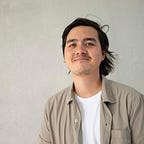Giving Form to Something Intangible: Designing the Cached Mirror
This post will cover some of the design decisions we made when developing the Cached mirror. Find out more about the project here.
It is a struggle to design something that doesn’t exist, even if it is just a prototype. First of all you have no reference, or directions to follow, so you have to justify and come up with these from scratch. The only certainty we had was to use the concept of the mirror somehow in the design. We had become interested in the idea of a mirror early on in the project, the connection to superstition and vanity related to our topic well. The metaphor of the mirror was also very powerful, a tool for self reflection, something we could use to show the interplay between our own reflection and digital one. And the mirror is also something common, found in many domestic spaces around the world. This domesticity was important to us, as it can ground whatever you design into something understandable. We needed to figure out, how the mirror looked, where it would go, and what it would do, so we created some constraints for ourselves to aid with this.
The Hotel Room
We knew we had to present this project somewhere in thecamp, but struggled with where. We discussed building a bespoke mirror room, to a photo booth and even placing this experience in the bathroom, but none of these sounded right. The discussions we had with Djordje Krivokapic (an expert in GDPR law and one of our collaborators for the project), was that under GDPR your data is personal and shouldn’t be seen or heard by anyone other than you. We needed it to be a private space, somewhere you can be alone with your data, a space that wasn’t open for anyone to see. A space where you can take time and reflect on your data, and be in a comfortable environment to do so.
Thecamp is a remote campus, many visitors often stay onsite in one of hotel rooms for a few days or months. As part of the second hive residency we had been staying in similar cozy rectangular rooms since April. We thought why not use one of the rooms as a private space you can book and have the experience in. This made a lot of sense, we could direct people to a room and manage who went in or out, and also hide the experience away from the fanfare of the main camp area. This also fit in with our interest of using the domestic and familiar in our project. A mirror would fit into a hotel room no problem, it is something ordinary, until it did something out of the ordinary, you wouldn’t notice it at all.
Finding Form
The early prototypes we made ended up being hidden in pieces of furniture you might find in a hotel room. We looked at creating a standing length mirror bookshelf, that would activate when you entered the space.
Other options included building a fake wall in the room to hide all the parts behind, so on the surface you would just see a hanging mirror. But we scrapped these ideas after prototyping them, the bookshelf mirror was too bulky and drew too much attention. And the wall was difficult to uninstall if we had to bring the experience elsewhere.
The brief we gave ourselves in the end was to, design a desktop sized mirror that would fit in with the aesthetics of the hotel room, something that gave the illusion that this was a parallel version of the room which you might be staying in. We also decided on a desktop size for portability, and was the smallest size we could make it to contain all the hardware we needed to make the mirror functional.
Circle Square
Assessing the interior of the hotel room and the furniture within it, everything was quite neutral and basic with no complex shapes or forms. To blend this object into the space we couldn’t create something too unfamiliar. Playing with the colours and materials that existed in the room, we thought the mix between woods and neutral colours worked.
Aline Martinez directed our attention to one of the rectangular mirrors in thecamp, the simplicity of it caught our attention. We also made a choice to go with a rectangular form as the rectangular screen behind the mirror would be easily visible in a circular shape, giving away the illusion that something was behind it.
Smart Home Assistants
Now we had a shape in mind, but still had to add the details. As Cached is a digital experience discussing psychometric data and the GAFA companies which make it their business to use our personal data for their gains. We pondered what might a smart mirror crossed with one of the GAFA home assistants look like.
We borrowed the visual language of these devices which are quickly becoming common in many homes, to come up with something minimal, but also placing emphasis on the speaker element of the device which we divided and covered with fabric. This would be where the voice would come from, much in the same way as an Echo or Google home works. We gave the mirror some rounded edges so it didn’t feel too sharp or obtrusive.
We took the visual language of current smart assistant devices and twisted it, not because it is aesthetically pleasing or trendy. But to make a comment and to be critical of the control of our personal data, the object acts as a substitute for any one of the GAFA devices if it were a mirror (something quickly becoming a reality.) It reminds us that once we let these new devices into our most intimate spaces we must pay the price. And more often than not this is with our personal private data.
